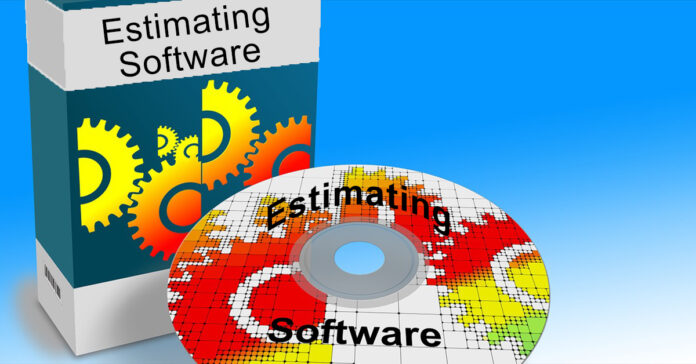If you are looking for Construction Estimating Software, the choices are many. I have personally been involved in overseeing an estimating group of 20 plus estimators and can tell you there was no way we could have bid the number of projects without using some form of mechanical Estimating software. Depending on your budget and sophistication with software there are lot’s of choices, but here are some of my thoughts if you are interested in purchasing a program. I will cover the usual cost encountered which vary per vendor, and then we’ll cover the features that you should ask about. You will also find a free Construction Estimating Software Checklist on our website at www.MEPAcademy.com that you should use when evaluating a purchase.
If you prefer to watch the YouTube version of this presentation then scroll to the bottom or click on this link. Best Mechanical Estimating Software.
Software Pricing
Construction Estimating Software ranges in price, which usually correspond to the features and the popularity of the program. Expect to pay anywhere from $1,500 and up for a basic license, but they are worth it, if you plan on bidding a lot of work. The latest trend in software is the subscription model, where you pay an annual fee to use the license. The fee would include technical support and any other options would be an additional charge, like training.

The more licenses you buy the better the discount. Of course you can get simple add-ons for Excel for much less but they won’t have the Features & Onscreen capabilities of the estimating programs covered here. There are additional fess as described further in this article.
Software Licensing Fee
The first cost is the cost of a software license for each trade, such as a separate fee for Sheet Metal and another cost for a Plumbing/Piping combination license. Additional licenses after the first one should be at a reduced cost. The combination Plumbing/HVAC Piping is a single license and is sometimes slightly higher than the sheet metal license.
The fee covers the right to use the software according to the terms of the license. Cost to purchase a single license range from a few thousand to upwards of $7,000 for a combo license that includes Piping/Plumbing & Sheet Metal, and for an annual subscription the cost ranges from $1,900 to $3,000 per year, there are some that provide a monthly lease agreement.
Labor Database – fee
Most construction estimating programs can use industry standard labor units published by MCAA (Mechanical Contractors Association of America), PHCC (Plumbing, Heating & Cooling Contractors Association), or SMACNA (Sheet Metal & Air Conditioning Contractors National Association). The database will give you unit labor values for each item and the total labor required for the project based on their published assumptions.
You’ll need to know how your site conditions differ from their standard assumptions and from your own historical database of productivity for a similar situation and project. You will make labor adjustments like you have in the past based on experience, such as Linear Feet per Man Day or a factor of the database values. This is a topic that requires its own article, as there are many aspects to adjusting labor. See our article on Adjusting Field Labor.

Remember that if you are a member of one of these organizations then there is probably no cost for the labor units, and if you’re not a member make sure to verify whether the price you are paying for the software includes these labor databases as they are considered proprietary information available by license only.
If you plan on using your labor units then this may not be an issue, but it is easier to start with one of these organizations database as they contain thousands of labor units based on industry surveys. The labor databases may cost you in the range of $200 to $1,000 for all three mechanical trades.
Material Pricing Database / Pricing Service – Fee
You will need to pay an annual reoccurring fee for a pricing service, like Harrison Publishing, Trade Service (Tra-ser), or Allpriser (Canada) which provides retail list prices of most major manufactures of pipe, valves and fittings. These companies charge an annual fee, but it is worth it if you do a lot of bidding. The alternative is to get pricing on each bid which is cumbersome and slow if you bid a lot of projects.
Most programs sold in Northern America come with a pricing update service and contain over 70,000 prices for pipe, valves and fittings. Whether it’s the Euro, Yen or Dollar the cost of commodities are constantly changing and you need to have a pricing method to stay current, and there is no easier method then a pricing service company. You will be notified when the next price update is available and you’ll download it automatically from the internet. This fee varies by vendor but expect a range of $300 to $1,400 per year.

You’ll need to put your discount multipliers for each manufacturer into the program so that you get net prices for your HVAC piping and plumbing materials, as the material database will be based on list prices. Whoever does your purchasing will know these discount values.
For sheet metal you’ll most likely need to manually enter the purchase price for round and rectangular ducts and fittings. If you fabricate your own duct work, then databases from SMACNA will have the labor units but you will still need to add the cost of materials.
Software Training Fee
Be sure to find out how much training will cost as this varies greatly from vendor to vendor and could be free if you use the internet. Some software providers will come to your facility or invite you to their training facility. You must analyze whether it is more feasible to travel your estimators to their facility or pay for them to come to your office to do the training. The best option is to have training done remotely using the internet, as this saves on travel cost.
If you have training at your office you will need to pay for the trainer’s travel cost which usually includes flight, hotel, car rental and a daily food allowance. But if the training is in your office you can usually have as many of your employees attend without any additional fees.
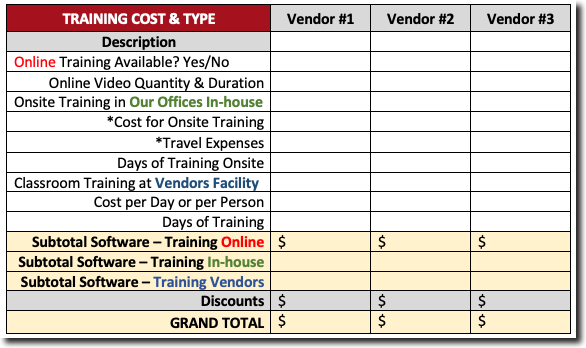
Be sure to find out the cost per person and per trade for those that do multiple trades. Some vendors provide unlimited training, so be sure to inquire about this very important aspect of your purchase.
The fees for training depend a lot on which training method that you implement, for web based training expect to pay up to $1,000 per estimator. For training in their facility you should expect a range from $1,000 to $2,500 per estimator, and for training at your facility expect to pay in a range of $3,000 to $7,000 including the trainers travel expenses.
Technical Support and Maintenance Fees
Most construction estimating software vendors have some form of technical support for their program and it is usually included in your annual subscription or maintenance fee. This fee is for any upgrades that might occur during the year and for technical support that you may require.

If you choose not to pay for the annual maintenance and support fee, then check to see if they have an hourly rate for when you might need support. This is an annual reoccurring expense that is based on the quantity of licenses that you purchase, also check to see if the first year is included in your software cost, either way you want to know what your cost will be for each year after the first. If you buy a subscription, then support and upgrades are usually included.

From our experience this fee varies greatly by vendor and is based on how many licenses you initially purchase, and can range from 5% to 15% of the license fee. The fee is more towards the lower end of the range the more licenses you own, hence the more negotiating power you have. Make sure to renegotiate this fee if your company grows and you add more licenses.
Total Software Cost Summary
The total cost for the construction estimating software will be composed of at least the following minimum cost range (Remember this is the most versatile of the estimating software the industry currently has, and there are less expensive alternatives with fewer features);
- Purchasing Software – Licensing Fee ($2,000 – $10,000 per License/Trade)
- Software Subscription – ($1,500 – $2,000)
- Labor Database Fee ($200 – $1,000)
- Material Pricing Database Fee (Annual Fee $300 – $1,400)
- Training Fee (free – $7,000)
- Technical Support Fee (annual fee of 5% – 15% of license fee)
Features
CAD/BIM Integration

One of the biggest benefits for those who have a detailing department, is the integration with various CAD programs and shop fabrication equipment.
This allows you to share one database which guarantees consistency from estimating to detailing to fabrication. This makes for a huge labor savings because when the detailing department finishes laying out the project, the CAD software program can export a file that can be imported into the construction estimating software program which will execute an estimate without any time spent doing a takeoff.
Ask if this feature is available with the construction estimating software and which CAD/BIM programs its compatible with.
Shop Fabrication Integration
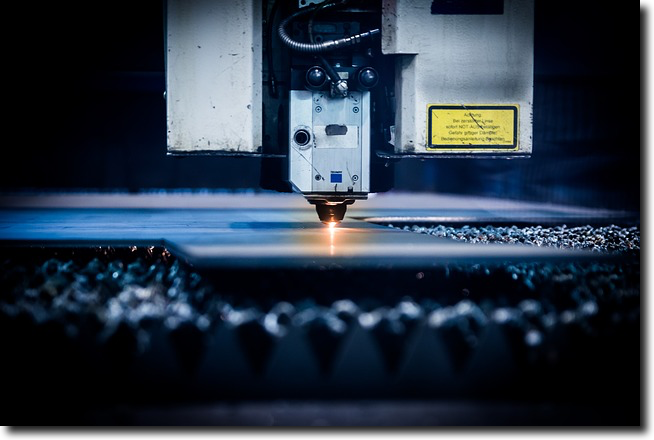
There are many construction estimating software programs that now integrate with shop fabrication equipment, especially for sheet metal.
The program shares an integrated database that keeps consistency between the estimating and detailing departments, and the fabrication shop.
The program would allow the estimating takeoff to be downloaded to the shop equipment for direct fabrication. In most cases you would want this to come from your detailing department to make sure what you fabricate will actually fit in the space allocated on site. Ask your software vendor what fabrication equipment if any the program is compatible with.
Assemblies
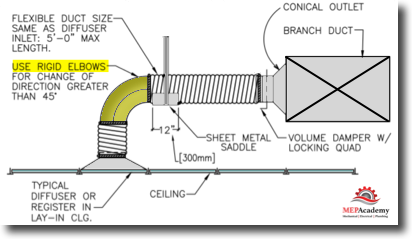
One of the great benefits of estimating software is its ability to provide equipment connections of various sizes quickly and with updated pricing. An assembly is all the pipe, valves and fittings around a piece of equipment or fixture.
For example, a Chiller or Pump often requires the same pipe, valves and fittings whenever one is installed, so why repeat taking off the same bill of materials when an assembly in the construction estimating software can retain all those parts for you. All you do is ask for a chiller connection of a particular size and the software calculates the bill of materials with the latest up to date pricing and includes all the material cost and labor for those parts.
The same for a typical diffuser connection as shown above. On a large project you could have hundreds of these connections. By having an assembly built, you’ll save time not having to re-enter the same lines repeatedly. The same applies to plumbing fixtures.
Ask your vendor how many pre-built assemblies come with the program. You can also build your own or modify the existing assemblies to the way you trim equipment or fixtures.
Estimating Reports and Spreadsheets
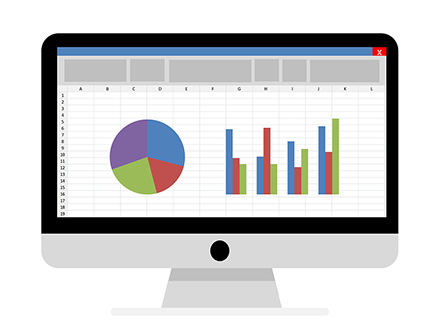
The estimating software can run many different reports, from material and labor summaries to the isolation of separate zones or alternates for review. The important thing is that if you have a special way of reviewing material and labor summaries and breakdowns, you’ll need the program to issue reports in the format you need for analysis.
It’s important to make sure that the software can give you reports the way you desire. You can pay to have the estimating software vendors make custom reports for you the way your company likes to see them, if the reports don’t give you what you want..
Most of the estimating software programs also come with an estimating spreadsheet for the summation of the information coming from the database from within the software, and for which you will add additional pricing to comprise a total bid.
To the spreadsheet you will add subcontractor pricing, equipment and specialty items not included in your estimating software. The estimating software might also export data that you would then import into another program like Excel. Ask about the versatility of the reporting capabilities.
Some of the estimating programs can export the information from the estimating software program directly into your company’s template proposal application like MS Word. Along with project information there is also the insertion of charts and estimating data.
Sheet Metal – Construction Standards
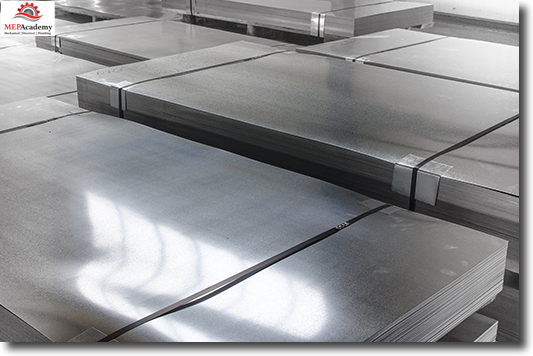
Contained in the sheet metal estimating program should be construction standards for rectangular, round, and oval duct based on SMACNA construction standards. In addition to standard galvanized duct and fittings, there will be the option to use other materials like stainless steel, black iron and aluminum.
Part of your implementation time will be spent setting up these standards according to the way you fabricate ductwork. The system should at least come setup with static pressure classes from minus two (-2) to positive six (+6) inches of static pressure.
The construction estimating program should contain the capability to either enter shop fabrication data or the cost to purchase your rectangular duct from a fabrication shop if you don’t have your own shop.
HVAC Piping – Construction Standards
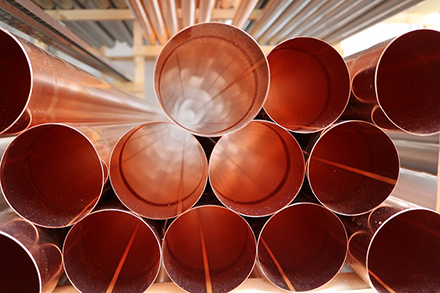
The database will contain different materials and methods of joining pipe and fittings together, from soldered, brazed, welded, grooved, pressed and push joints.
Estimating software programs contain many different piping material types that can be combined in various size breaks, such as using copper up to 2” and carbon steel from 2-1/2” and up, all setup under one system, such as Chilled Water, Heating Hot Water or Condenser Water.
The question to ask is how many systems come pre-setup and which ones? If you use various other types of materials like Polypro or Press-fit type fittings, be sure to ask if they are available in the database. Often if they haven’t been setup already this will create extra time to implement the system for the type of materials you commonly use.
Plumbing – Construction Standards
The mechanical estimating software will also have many piping materials that can be combined to comprise the required systems for plumbing, such as copper, cast iron, plastics, ABS and others. The same questions apply here as for the HVAC piping construction standards above.
Automatic Generation of Fittings, Hangers and Joints
Forget about counting hangers as the software will automatically provide hangers according to the hanger spacing set in the construction standards. All you need to do most often is to indicate what the upper attachment will be fasten to, such as concrete, wood or steel beams.
Another great feature is the automation of fittings and joints including all the parts that comprise a joint. No more worrying about or having to remember what is required each time you make a fitting or joint connection.
Once your setup, or confirm that the database holds the correct information for the materials you use on your standard fittings and joints, the system will provide a hanger per the hanger schedule in the software, and all the required components surrounding an elbow, tee, joint or connection without you having to tell the system where the fitting is or the parts needed. This makes for extremely fast take-offs because there is no need to take-off each individual fitting. Ask your mechanical estimating software vendor if this feature is available.
On-screen Take-off
Onscreen capabilities allow you to do takeoffs directly from digital plans on your computer screen, reducing the time and cost of printing and manually marking paper copies. The On-Screen digitizer supports a wide variety of popular CAD formats in addition to the following; PDF, JPEG, TIF, GIF, PNG and many others. Here is the Trimble AutoBid Mechanical for taking of HVAC piping. It will give you an idea of how Onscreen takeoff works for the other mechanical trades and estimating software vendors.
Check with your vendor to make sure the program accepts your file types. The program should allow real time panning, zooming and marking of very large CAD drawings while minimizing the impact on the computer’s performance. On-screen takeoffs have moved away from the use of digitizers or computerized tabletops.
Specification Swapping
Having this feature allows you to switch the specification of your takeoff with another specification type without having to input each item into the system over again. For instance, if you took off everything as being copper, then using this feature you could just swap out the copper construction specifications with any other specification, like black iron, carbon steel, or some form of plastic.
Mobile/iPad Option

Some of these mechanical estimating software companies offer mobile applications that are compatible with their main program. This allows you to do a field takeoff and then import a file into the main estimating program back at the office. Ask about this feature and its cost and capabilities.
They may integrate with Apples iPad or an Android, be sure to ask.
Comparing Drawings
When you receive changes to the drawings that you have already done a takeoff on, this feature allows the software to compare the two drawings and highlight or indicate the differences. This saves time when addressing addendums and change-orders.
Documentation

This is one area where you may find that some of them are lacking, as it takes considerable effort to put together and keep updated documentation on the functionality of the mechanical estimating software.
Many vendors now have videos online and don’t provide any written documentation. Be sure to ask about the type and amount of documentation available. Having the ability to refer to training videos or documentation is helpful when you want to learn more about the programs capabilities or just for troubleshooting a simple problem before calling technical support.
Accounting Integration
Some construction estimating software programs have the capability to export data to various accounting software programs. This is useful if you want to save time in setting up a project for the construction department for labor and material tracking. Having the ability to export all the material and labor values from your estimating program broken down by zone, floor or system type is a convenient and fast way to transition a successful project from estimating to operations quickly.
It’s important to make sure that your accounting software is on the estimating software’s list of compatible programs if this is important for your company. Its possible also that the estimating software can export into Excel or a commonly used format like CSV or an ODBC Compliant file.
Project Scheduling Integration
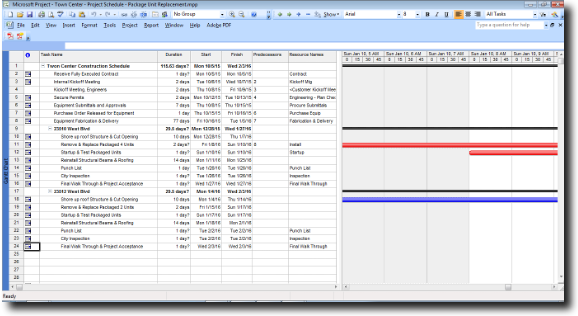
Again another feature that can be useful if you want to export data into other programs, in this case scheduling software like MS Project. This is another time saving feature that is beneficial for those that provide construction project schedules in the various scheduling programs available.
Network based or Standalone based License
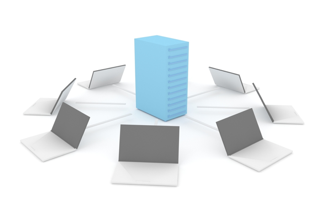
Licensing comes in various forms for the different methods of your company’s IT setup and estimating accessibility requirements. If there is just one estimator, then the question comes down to whether you want the program to reside on a network server or the Cloud which is accessible from many locations or if the program will reside on your laptop or desktop and be accessible to just yourself (Stand alone).
Often with a Network based installation it doesn’t cost anymore if you have one or ten estimators connected to the network software license, because the cost is for the quantity of licenses, not the quantity of estimators. If you have four estimators and only one license, then only one estimator can use the software at a time, and you only pay for one license. You must evaluate how often the estimating software will be used and for which trades.
A lot of programs are now cloud based, where most of the software resides on servers that are housed in some remote offsite facility. You’ll have a license portal that will confirm you have a valid paid for license before being granted access to the remote server.
Technical Requirements
Be sure to verify that your current computer has the required specifications to handle the requirements of the construction estimating software program. With the increased functionality and graphics used with some of these programs you want to make sure that your computer can keep up, especially if you are using a network license with many users in different locations.
If using a network and you have users in different cities or locations all using the same server to retrieve the Estimating Program, be sure you have the band width to handle the data transfer required. Make sure to ask all the pertinent questions before purchasing any construction estimating software. The software vendor will have a technical requirement spec sheet for computers to meet.
Implementation of the Program
It takes considerable effort to get the program setup to match your company’s way of doing business. Most programs come setup with the basic construction standards, but if yours differ you’ll need to spend time implementing changes to match your company’s’ way of building projects. Whether you do sheet metal, HVAC piping or plumbing, there are construction standards that come prepackaged with most software programs.
Often SMACNA standards or something similar for sheet metal fabrication will come preset and will need to be adjusted for any local code variances in joints, seams, gages or reinforcement. HVAC piping and plumbing will have copper, cast iron no-hub, plastic, carbon steel and refrigeration piping already setup, but once again you must confirm that it is the same as your company’s construction standards and the local code authority.
There is also the time required to enter pricing data for the sheet metal and piping/plumbing discount multipliers.
Make sure to allow time for implementation. My experience is that most construction estimating software vendors understate the amount of time it takes to implement their programs, so I would expect anywhere from 2 to 8 weeks depending on how many systems you need and how close your company standards are to the boxed standards that come with the mechanical estimating software program.
Estimator Experience
Do you or your estimator have any experience using construction estimating software? Training will be required in the range of 3 to 5 days. Beyond this you will need to invest time implementing and learning the nuances of the program to become efficient at take-offs including time to maintain the database. Anyone that has the basic understanding of computers will learn quickly how to do takeoffs, and someone who understands construction standards will be required as administrator for implementation and liaison with technical support staff.
Estimating Software Checklist
Use the enclosed 6-page Estimating Software Checklist to compare the various estimating software programs and to make sure you ask the right questions. See below for download link for free Estimating Software Checklist before investing in software.
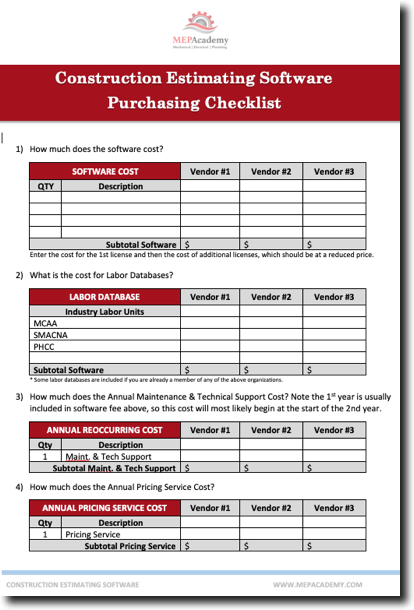
Estimating Software Demonstration
FREE Construction Estimating Software Demonstrations
We recommend that you get a FREE demonstration of the various software programs so you can evaluate your needs against the available features and cost of the different construction estimating software programs.
Estimating Software Vendors
FastDuct
Software Buying Checklist
For a complete Checklist of the Questions you should be asking any construction estimating software vendor visit the www.MEPAcademy.com for a FREE copy. Look for the download link at the bottom left of the below document screen.
 Loading…
Loading…
Using estimating software makes your life easier, but there is an investment of time and money to get it implemented and keep it going. Discover the advantages with a FREE demonstration.
Introduction to Sheet Metal Estimating (Free Course)
- Chapter #1 – Introduction to Sheet Metal Estimating
- Chapter #2 – How to Read the Specifications
- Chapter #3 – Understanding the Front End Documentation
- Chapter #4 – Sheet Metal Estimating Standards
- Chapter #5 – Labor and Material Databases
- Chapter #6 – MEP Estimating Software


